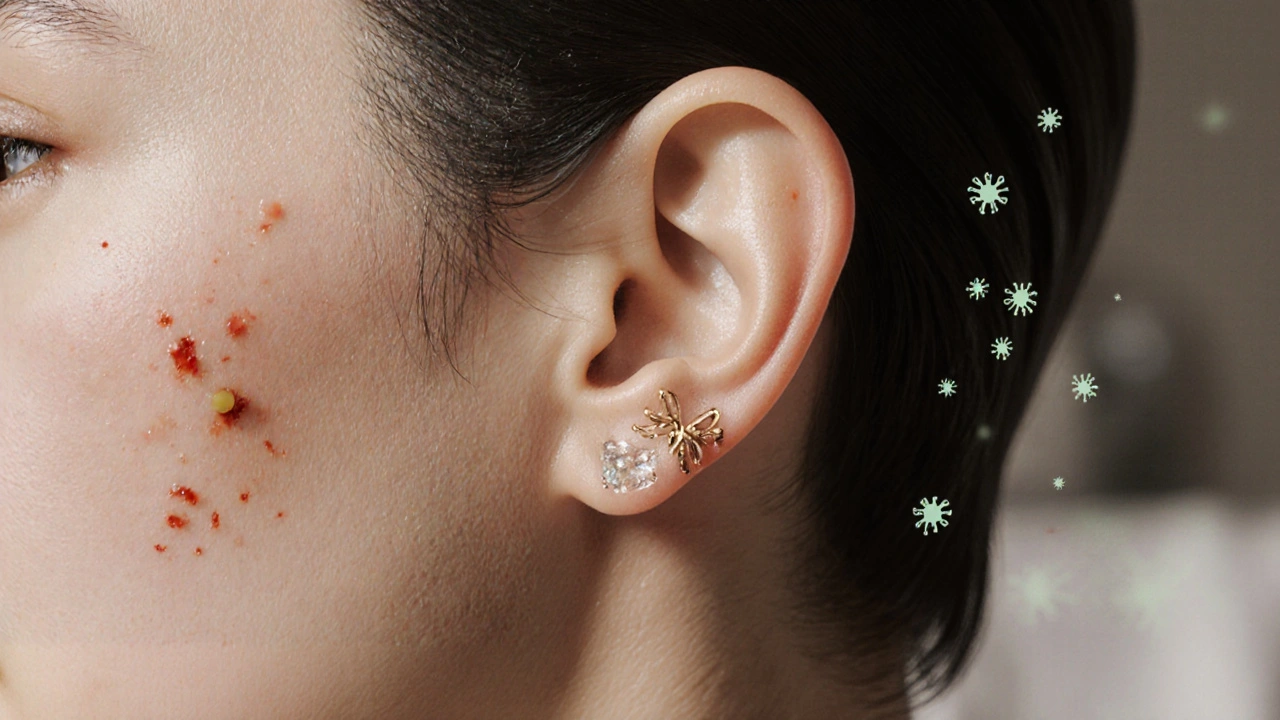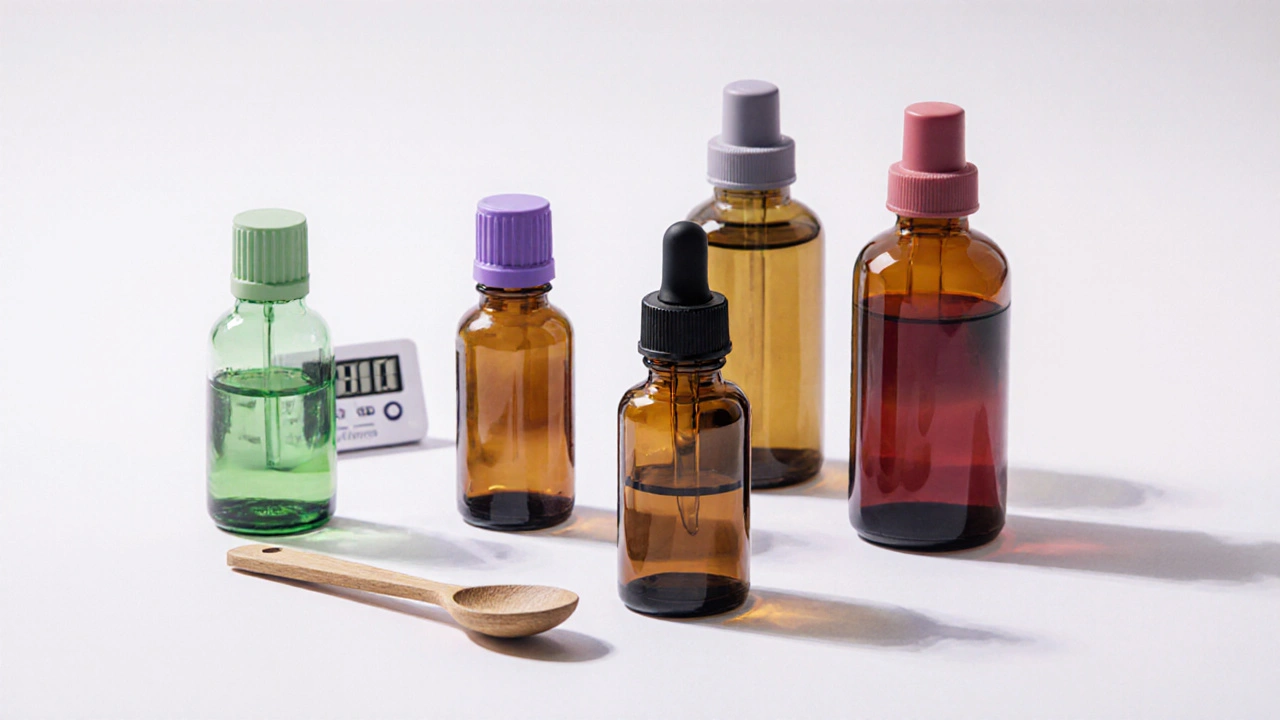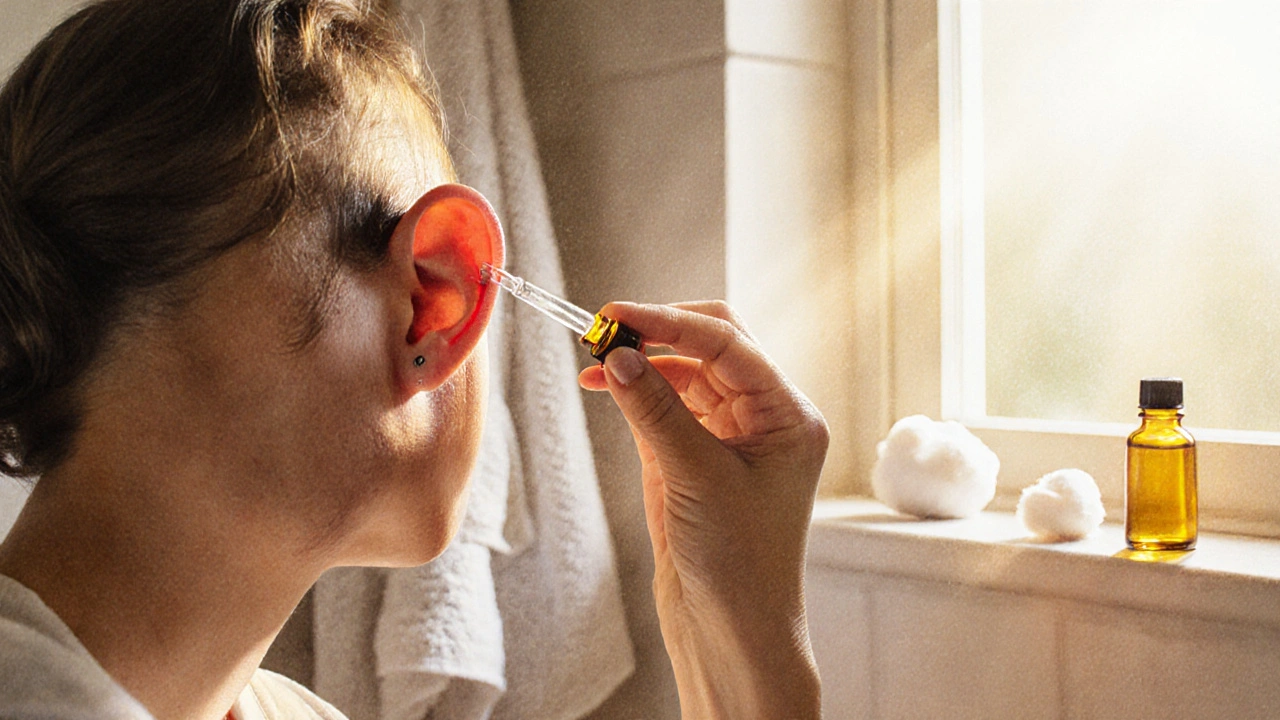Essential Oils for Ear Canal Infections: Full Guide

Essential Oils for Ear Infections Calculator
Dilution Result
Top Essential Oils for Ear Infections
Tea Tree Oil
Terpinen-4-ol
Antibacterial & Antifungal
Lavender Oil
Linalool
Anti-inflammatory & Antimicrobial
Clove Oil
Eugenol
Antibacterial & Analgesic
Oregano Oil
Carvacrol & Thymol
Broad-spectrum Antimicrobial
Ear canal infections, also known as otitis externa, can turn a simple swim or shower into a painful ordeal. While doctors often prescribe antibiotic ear drops, many people wonder if a more natural route can help clear the infection and soothe irritation. This guide walks through the science behind essential oils, highlights the most researched oils, shows how to use them safely, and compares them with conventional treatment so you can decide what works best for you.
Key Takeaways
- Essential oils such as tea tree, lavender, and oregano have documented antimicrobial properties that can target the bacteria and fungi behind otitis externa.
- Proper dilution (typically 1-2 drops of essential oil per teaspoon of carrier oil) is crucial to avoid ear canal irritation.
- Clinical evidence supports essential oils as a complementary approach, but they should not replace prescription antibiotics for severe infections.
- Watch for red flags: worsening pain, fever, or drainage that persists beyond three days - these require medical attention.
- Follow a step‑by‑step application routine to maximize safety and effectiveness.
essential oils for ear infections have become a hot topic in natural health circles, and the interest is backed by a growing body of studies. Below we dig into the details.
What Is an Ear Canal Infection?
Ear Canal Infection is an inflammation of the external auditory canal, often caused by bacteria such as Staphylococcus aureus or fungi like Aspergillus species. Typical symptoms include itching, redness, swelling, and a muffled hearing sensation. In most cases, moisture trapped in the canal after swimming or excessive cleaning creates a perfect breeding ground for microbes.
When the infection is mild, the ear may clear up with home care. However, more aggressive cases can spread deeper, leading to pain, pus, and even temporary hearing loss. The standard medical response is a short course of antibiotic ear drops, sometimes combined with a steroid to reduce swelling.

How Do Essential Oils Work?
Essential oils are volatile compounds extracted from plants. Their antimicrobial action stems from components like terpenes, phenols, and aldehydes, which can disrupt bacterial cell walls, inhibit fungal spore germination, and reduce inflammation.
Research in journals such as *Journal of Antimicrobial Chemotherapy* and *International Journal of Cosmetic Science* has shown that several oils exhibit activity against the very microbes that cause otitis externa. For instance, tea tree oil’s terpinen-4-ol and lavender oil’s linalool have been documented to lower bacterial counts by more than 90% in vitro.
Top Essential Oils for Ear Canal Infections
Below are the most studied oils, their key active constituents, and what the science says about their ear‑friendly potential.
-
Tea Tree Oil (Melaleuca alternifolia) contains terpinen‑4‑ol, a potent antibacterial and antifungal agent. A 2015 study found it reduced S. aureus growth by 99% after 30 minutes of exposure. Use a 1% dilution for ear applications.
-
Lavender Oil (Lavandula angustifolia) is rich in linalool and linalyl acetate, both of which calm inflammation and have modest antimicrobial effects. Clinical trials on skin infections reported faster healing times, suggesting potential ear benefits when diluted.
-
Clove Oil (Syzygium aromaticum) packs eugenol, a phenolic compound strong enough to kill resistant bacteria. In lab settings, eugenol inhibited Pseudomonas aeruginosa-a common ear pathogen-at concentrations as low as 0.5%.
-
Oregano Oil (Origanum vulgare) boasts carvacrol and thymol, which together provide broad‑spectrum antimicrobial coverage. A 2020 study noted that a 0.75% oregano oil solution stopped fungal growth on ear canal models.
Safety First: Dilution, Carriers, and Precautions
Essential oils are powerful; applying them undiluted can burn the delicate skin inside the ear. The rule of thumb is 1-2 drops of essential oil per 1teaspoon (5ml) of carrier oil.
Carrier Oil (e.g., coconut, olive, or sweet almond oil) serves as a gentle vehicle that spreads the essential oil evenly and reduces irritation. Coconut oil also has mild antimicrobial properties, adding a bonus effect.
When mixing, use a clean dropper bottle, label it clearly, and store it in a cool, dark place. Always perform a patch test on the forearm before the first ear application; if redness or itching occurs, discontinue use.
Never insert a needle‑point dropper too deep-just a few drops into the outer ear canal is enough. If you have a perforated eardrum, chronic ear disease, or are pregnant, consult a healthcare professional before using any essential oil.

Essential Oils vs. Conventional Antibiotic Ear Drops
| Attribute | Essential Oils (diluted) | Antibiotic Ear Drops (e.g., Ciprofloxacin) |
|---|---|---|
| Primary Action | Broad antimicrobial, anti‑inflammatory | Targeted antibacterial |
| Onset of Relief | 2-4hours (depends on dilution) | 30minutes to 1hour |
| Side‑Effect Profile | Possible irritation if not diluted | Rare allergic reaction; may cause ototoxicity if misused |
| Prescription Needed | No (over‑the‑counter) | Yes (prescription) |
| Cost (per treatment) | $5-$15 for a 10ml bottle | $20-$40 for a 7ml prescription |
| Evidence Base | In‑vitro studies, limited clinical trials | Extensive clinical trials, FDA‑approved |
Both options can be effective, but the choice hinges on severity, accessibility, and personal preference. For mild infections with no discharge, a diluted essential oil regimen can be tried first. If symptoms persist beyond 48‑72hours, switch to-or add-prescribed ear drops.
Step‑by‑Step Guide: Using Essential Oils for Ear Canal Infections
- Gather supplies: a small amber dropper bottle, your chosen essential oil, a carrier oil, cotton balls, and a clean towel.
- Prepare the blend: Add 1drop of essential oil to 1teaspoon (5ml) of carrier oil. Shake gently.
- Warm the mixture: Hold the bottle in your hands for a minute. Warm oil penetrates the skin better, but never overheat.
- Position yourself: Tilt your head so the affected ear faces upward. Use a towel to catch any drips.
- Apply: Using the dropper, place 2-3 drops of the diluted oil into the outer ear canal. Avoid forcing the dropper deep.
- Let it sit: Keep your head tilted for about 5minutes to allow absorption.
- Clean up: Gently wipe any excess oil from the outer ear with a cotton ball. Do not insert cotton into the canal.
- Repeat: Use the blend up to 3 times a day for 5‑7days, monitoring symptoms.
If you notice increased pain, swelling, or a foul odor, stop the treatment and seek medical care. Remember, essential oils complement- they don’t replace-proper medical evaluation for serious infections.
Frequently Asked Questions
Can I use essential oils if I have a ruptured eardrum?
No. A ruptured eardrum allows substances to reach the middle ear, where oils can cause irritation or infection. Seek a doctor’s advice before trying any home remedy.
How long does it take for essential oils to clear an infection?
Mild cases often improve within 3‑5days if the oil is diluted correctly and used consistently. More stubborn infections may need 7‑10days or a shift to prescription drops.
Is it safe to use essential oils for children’s ear infections?
Children’s skin is more sensitive. Use a maximum dilution of 0.5% (1drop of oil in 2teaspoons of carrier) and limit applications to once daily. Always consult a pediatrician first.
Which essential oil is the most effective against ear canal fungi?
Tea tree oil and oregano oil both show strong antifungal activity in lab studies. Tea tree is often preferred for its milder scent and lower irritation risk when properly diluted.
Do essential oils interfere with prescribed antibiotic ear drops?
There is limited evidence of direct interaction. However, using both at the same time can increase the chance of irritation. Space applications-e.g., antibiotics in the morning, essential oil blend in the evening-if both are recommended by a clinician.
Bottom line: essential oils can be a helpful, low‑cost ally for mild ear canal infections when used responsibly. They’re not a magic cure, but with the right oil, proper dilution, and close symptom monitoring, many people find relief without a prescription. When in doubt, especially if pain intensifies or you develop a fever, it’s safest to see a healthcare professional.

Shriniwas Kumar
October 5, 2025 AT 15:31When delving into otic phytotherapy, the lipid solubility of terpinen‑4‑ol in tea tree oil warrants consideration alongside the viscoelastic properties of the carrier medium to ensure optimal mucosal diffusion.
Jennifer Haupt
October 11, 2025 AT 10:33Indeed, the synergistic interaction between linalool’s anti‑inflammatory cascade and the carrier’s emollient base can attenuate cytokine release, thereby fostering a more soothing environment for the auditory canal.
NANDKUMAR Kamble
October 17, 2025 AT 05:26It's worth noting that major pharmaceutical conglomerates have been systematically suppressing natural otic remedies, fearing the loss of market share to inexpensive essential oil protocols.
namrata srivastava
October 23, 2025 AT 00:20While your conspiratorial musings are colorful, the pharmacognostic evidence supporting eugenol’s analgesic properties remains robust and peer‑reviewed.
Priyanka arya
October 28, 2025 AT 19:13🚨 Did you ever notice how the OEMs of ear drops never mention oregano oil 🍃? Might be a hidden agenda to keep us guessing! 🌿
Loren Kleinman
November 3, 2025 AT 14:06When you consider the pathophysiology of otitis externa, the primary concern is the disruption of the ceruminous gland barrier, which normally provides both antimicrobial peptides and a hydrophobic seal. Essential oils, when properly diluted, can supplement this barrier by delivering bioactive terpenes that possess both bacteriostatic and anti‑inflammatory properties. For example, tea tree oil’s terpinen‑4‑ol interferes with bacterial cell wall synthesis, while lavender’s linalool modulates the NF‑kB signaling pathway, reducing pro‑inflammatory cytokine production. Oregano oil, rich in carvacrol and thymol, exhibits broad‑spectrum activity against gram‑positive and gram‑negative organisms, which is particularly useful in mixed‑flora infections. However, the otic canal is delicate; undiluted oils can cause irritation, epithelial desiccation, and even exacerbate inflammation. Hence, a typical safe dilution ratio is 1% essential oil to carrier – that is, about 6 drops of essential oil per 30 ml of carrier oil. Perform a patch test on the inner forearm 24 hours prior to any ear application; watch for erythema, itching, or burning. If any of these symptoms occur, discontinue use immediately. Additionally, avoid using essential oils in the presence of a perforated tympanic membrane, as the compounds could traverse into the middle ear and cause ototoxicity. Finally, remember that essential oils are complementary, not a substitute for conventional antimicrobial therapy when a bacterial infection is severe or unresponsive. Always consult a healthcare professional if symptoms persist beyond 48‑72 hours, especially if you experience vertigo, severe pain, or hearing loss. By integrating thoughtful dilution, proper carrier selection, and vigilant monitoring, essential oils can become a supportive adjunct in managing mild ear canal infections.
Sabrina Goethals
November 9, 2025 AT 09:00Wow, that was a lot of info, lol, i guess it's good to know the details, but yeah, keep it simple, don't overthink it, okay?
Sudha Srinivasan
November 15, 2025 AT 03:53Use a proper dilution or you're just hurting yourself.
Jenny Spurllock
November 20, 2025 AT 22:46Curiosity aside, a mild antiseptic action is achievable with a 0.5‑1% dilution, which aligns with the skin‑tolerability thresholds established in dermal studies.
Bart Cheever
November 26, 2025 AT 17:40Honestly, the whole essential‑oil‑in‑the‑ear thing feels like a fad that over‑complicates a simple infection.
Maude Rosièere Laqueille
December 2, 2025 AT 12:33If you decide to try this approach, make sure to use a high‑quality carrier oil such as fractionated coconut or sweet almond, as these have minimal allergenic potential and help the essential oil disperse evenly.
Amanda Joseph
December 8, 2025 AT 07:26Oh great, because nothing says ‘professional medical advice’ like a DIY oil mix, right?